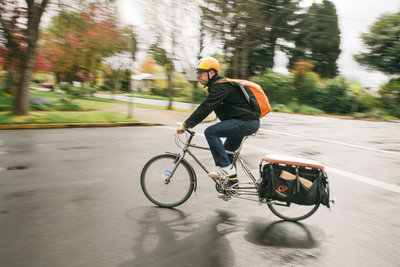
Many Eugeneans have long felt relatively safe (around most drivers, that is), cycling for transit or pleasure, but others are so intimidated by the safety concerns of urban cycling — and not knowing what to do in a scary situation — that their fears prevent them from cycling to save the planet.
Never fear, there’s a class for that. After attending training for League of American Bicyclists instructors in 2009, biking organization GEARs (Greater Eugene Area Riders) founded a nonprofit education corporation called GEARs Education. Eugene riders can even escape hundreds of dollars in fines from a first cycling ticket by attending a $10 class.
GEARs instructors Paul Adkins and Richard Hughes say that the class covers important rules that many riders don’t know, safety tips, strategies for reacting to unsafe drivers, a bit of bike maintenance and, for many, a newfound sense of confidence.
“It’s amazing how many people ride around feeling like they have no idea what bikes are supposed to do,” Adkins says, simply because they have to do independent research to figure out rules and regulations. But that uncertainty isn’t entirely surprising, Hughes says, because a lot of people grow up thinking of bikes as toys rather than transportation. “If people didn’t have to take any drivers education class, they would just get in the car and drive.”
Both instructors say that one of the biggest misconceptions in Eugene is that cycling on the sidewalk is a safer option than cycling in the road. “If you’re on the sidewalk and you’re not moving, your danger of being hit by a car is extremely low, but as soon as you start moving on the sidewalk, there are far more things to likely impact you,” Adkins says. “Every single driveway becomes an opportunity to get hit.”
That might not always be true when cyclists are traveling as slowly as most pedestrians, but, Hughes says, when riders speed up, drivers don’t expect them to be there, especially when cyclists are traveling in the opposite direction of an adjacent lane of auto traffic.
In scary scenarios, Adkins points out that brakes get very, very important, but they’re easy to neglect if most of your riding is done in flat areas of Eugene. He says that mechanical brakes are safer than bikes that require a rider to apply backward pressure, even for experienced cyclists.
Adkins says he also cautions his own kids not to let someone waving them on encourage them in any way. “Just because someone’s waving you on doesn’t make it safe at all,” he says. Instead, he tells them to check for vehicles and pedestrians obscured by a friendly driver’s vehicle and in other travel lanes.
Safe Cycling, the three-hour version of the class, is more condensed and doesn’t give cyclists the opportunity to get out on the road. Traffic Skills, the nine-hour class, culminates in a ride through challenging traffic situations to practice the newfound knowledge. Both are $10 and come with a workbook. Traffic Skills for Families lasts for three hours and costs just $5.
But until you roll into a GEARs safety class, keep your cycling brightly colored, lit and obvious: “Unless cyclists can be predictable and visible,” Hughes warns, “it’s hard to be safe.”
To learn more about GEARs Education’s safety classes, check out eugenegears.org/classes